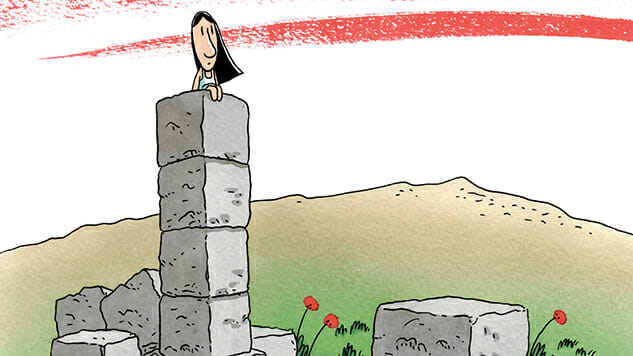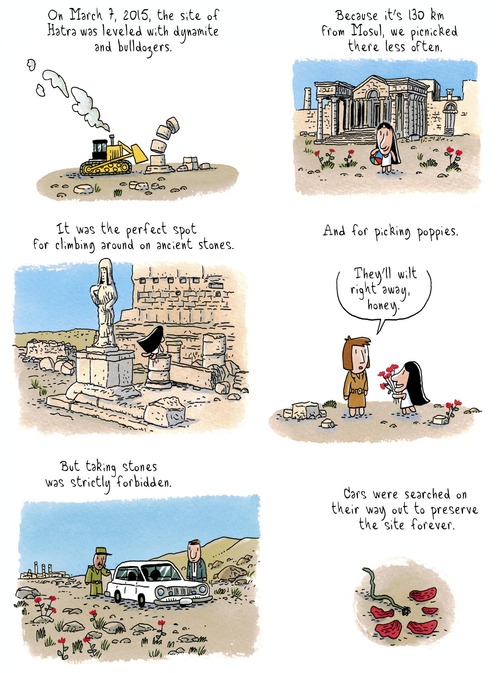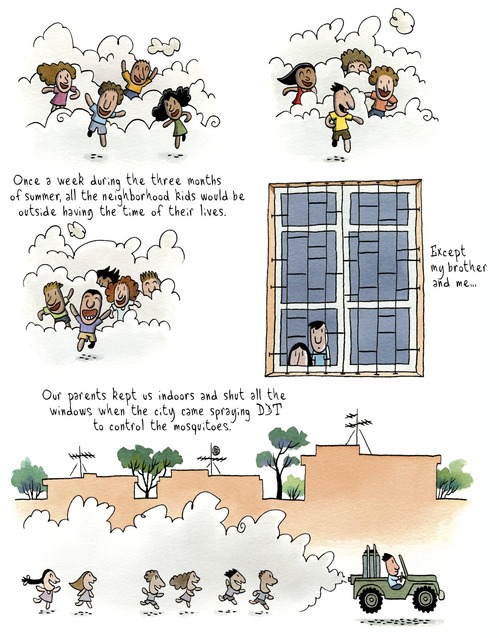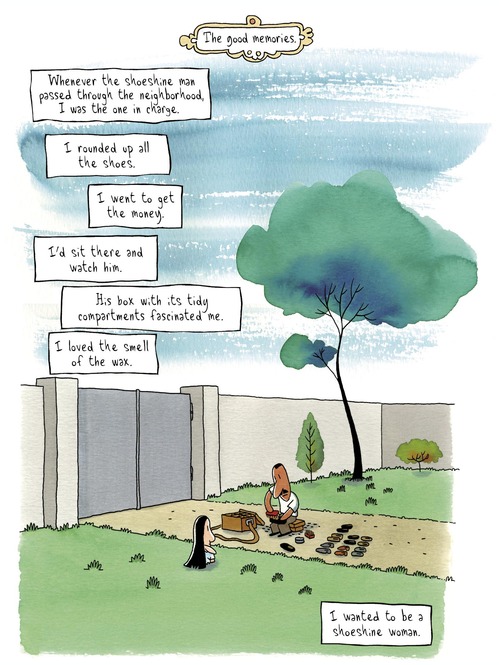Brigitte Findakly & Lewis Trondheim Show the Personal Vulnerability of Middle-Eastern Strife in Poppies of Iraq
Comics Features Poppies Of Iraq
Brigitte Findakly was born in 1959 to an Orthodox Christian Iraqi father and a French mother. She grew up in Mosul, Iraq, but moved to France with her family in 1972. Since then, she’s visited only a few times and not since 1989. Most American comic readers may recognize her as the wife of French cartoonist Lewis Trondheim, in whose Little Nothings strips she appears as a sort of long-beaked bird creature. (Trondheim interprets himself as the same mixture of human and animal, but with a shorter, sharper beak.) But Findakly has a cartooning career of her own, as a colorist, but Poppies of Iraq, an autobiography of sorts and a collaboration with her husband, offers far more insight into her storytelling prowess.
It’s a slim book with an episodic structure, and it doesn’t try to give an in-depth history of the country. Instead, it dips in and out of Iraq’s trajectory, sometimes discussing facts, sometimes politics and sometimes cultural differences, like the fact that Iraqis refuse second helpings of food, forcing the host to insist in order to get anyone to take more. The graphic novel doesn’t attempt a sweeping narrative scope, but its impact lies in the personal nature of its story. Reading a fat book about the history of a place rarely leaves the reader with empathy for the people who live there. This restrained story about individuals, on the other hand, builds bridges and leads to greater understanding, case by case by case. Findakly and Trondheim answered some questions via email about their collaboration process (they didn’t get divorced!), character design and the importance of distance in creating this story.![]()
Paste: Can you talk to me about the process of creating this book? I know Brigitte wrote, Lewis drew and Brigitte colored, but it was probably a little less separated out than that. Who did what and how did you collaborate?
Brigitte Findakly: I began with notes I had jotted down over the past few years—the things I remembered about Iraq. As I told Lewis an anecdote, often, he would ask me follow-up questions to determine more about the circumstances and the places I was describing. He also asked for photos. When I needed a little more help remembering, I’d ask my mother or my brother. Based on that information, he would edit and structure the anecdote as a comic. I would come back with more precise details and small clarifications. He would draw the page and I would color it. Sometimes I would ask him if what we were doing in Poppies was too elliptical, and he reassured me that you need to have confidence in the reader’s intelligence.
Paste: You both have a history of collaboration with other writers/artists: how is working together with each other different from working with other people?
Findakly: Lewis was there to listen, open. He knew better than anyone what would be good or bad for the book. He’s been making comics for 30 years; he knows how to structure a story. The only danger of working on this project was the risk of divorce over book-making disagreements. But that didn’t happen!

Poppies of Iraq Interior Art by Brigitte Findakly and Lewis Trondheim
Paste: Do you prefer to work collaboratively?
Findakly: I tried to write the book by myself but my writing was too sentimental. The book called for a certain distance that I wasn’t able to create on my own.
Paste: How did you know this could be a book? What was the deciding factor in starting to make it? In other words, why now?
Findakly: My father was losing his memory, my family was emigrating to every corner of the earth and Daesh (ISIS) invaded my birthplace, Mosul. It was too many things all at once. I felt the need to write down certain memories from my childhood. I wanted to show a different side of Iraq, and I wanted to preserve those memories for my children. I could tell that this would make enough material for a book, the problem was figuring out how that book would look.
Paste: The visuals are fairly cartoony and simplified. Why? Lewis, I know that’s your style, but these are even more so than usual (for example, the people don’t really have hands and feet).
Lewis Trondheim: I have never drawn in a realistic style. And even if I had wanted to, I wouldn’t have succeeded. Even when I force myself to draw more realistically, or I ask someone else to handle the drawings on a book, I think that a minimalist drawing’s impact is that it allows the reader an easier entry point into a story. Usually I draw people as animals, here, I’ve drawn them as humans, but using the bare minimum of detail, like a children’s drawing that’s got a bit more structure to it. And we made the decision to place Brigitte’s family photos as anchors intermittently throughout the book—I initially used these as resources for my drawings. Even if the reader knows Poppies is a true story, seeing the photos makes it all the more striking.

Poppies of Iraq Interior Art by Brigitte Findakly and Lewis Trondheim
Paste: The book is more a series of related stories than one long, unified narrative. What led to that?
Findakly: We were working for the newspaper Le Monde in France. Each week they would publish a chapter. And so it made more sense to tell stories that didn’t need to be read in order, but were just short strips. This format happened naturally, and when we went back to read the whole thing together, we would rework certain pages here, add pages there and so on to create a coherent book from the strips.
The most important thing for us was not to get lost in the pathos of the situation. We didn’t want to romanticize the history or recreate conversations. So we stuck with a very fact-based history, with many anecdotes, as well as humor, and the necessary shifts back and forth in time, but all without exaggerating or blowing things out of proportion.
Paste: It seems like there have been a lot of comics about the Middle East (Joe Sacco’s Footnotes in Gaza and Palestine, Marjane Satrapi’s Persepolis, Riad Sattouf’s The Arab of the Future, Guy Delisle’s Jerusalem, Harvey Pekar’s Not the Israel My Parents Promised Me, etc.). Why do you think that is?
Findakly: The Middle East has a very rich cultural history but is sadly known more for the instability caused by the various conflicts that have taken place there or are taking place there currently. If one has lived there or even if one spends some time in the Middle East, it becomes important to talk about this place in a real way. The books you mention, as well as our own, offer an intimate testimony that goes above and beyond to take these very complex conflicts and explain why and how they happened.

Poppies of Iraq Interior Art by Brigitte Findakly and Lewis Trondheim
Paste: Did you make a conscious effort to distinguish your book from them?
Findakly: I wasn’t too worried because every book is different since every author has had his or her own experiences. In Poppies of Iraq, I describe my memories of growing up in the 1960s and early 1970s. My life in Iraq wasn’t a horror story or a tragedy, it was just the story of one family. I didn’t want to romanticize it, so we chose to avoid bombastic or over-the-top scenes. I didn’t want to invent dialogue, re-enact scenes or overstate my experiences.
It seemed very important to both myself and Lewis that the focus of the story remain very pragmatic, and that we were efficient about the way we told my story. Just because you spill your guts about every last detail, that doesn’t mean you’ve told an interesting or a moving story. Sometimes keeping the story more restrained allows the reader to develop more empathy for a situation. There is certainly a lot of emotion in this book, but we didn’t want to play on people’s emotions.

Poppies of Iraq Interior Art by Brigitte Findakly and Lewis Trondheim
Paste: How did the translating process work? Was there a lot of back and forth?
Findakly: Helge Dascher translated this book. She lives in Quebec and I live in France. We spoke a number of times over Skype, sometimes because she wanted to be certain she had understood certain turns of phrase, sometimes because she wanted to clarify the details of certain events described in Poppies. I very much appreciated her method of working, her way of immersing herself in each story to be able to translate it as best she could.
Paste: What do your kids think of the book?
Findakly: My children (21 and 22 years old respectively) very much appreciated this book because they knew very little about my life and about the life of my family in Iraq. Before this book, I couldn’t see myself saying to my children, “Come sit down next to me, I’m going to tell you about my life in Iraq, from when I was born until when I arrived in France.” My brother’s children are older than my own, and they were also very touched by the book. They told me that it helped them better understand their father and their grandparents.
